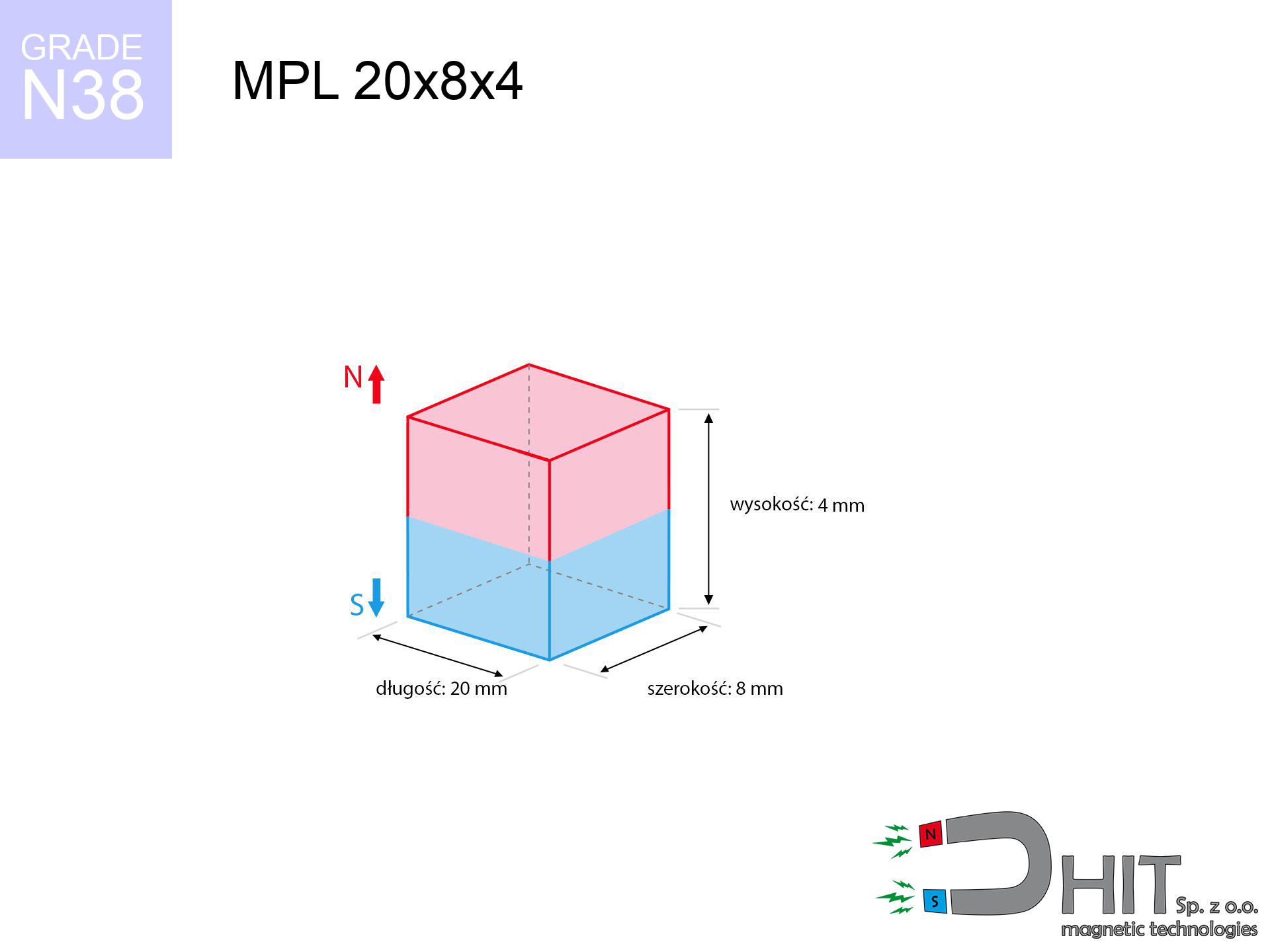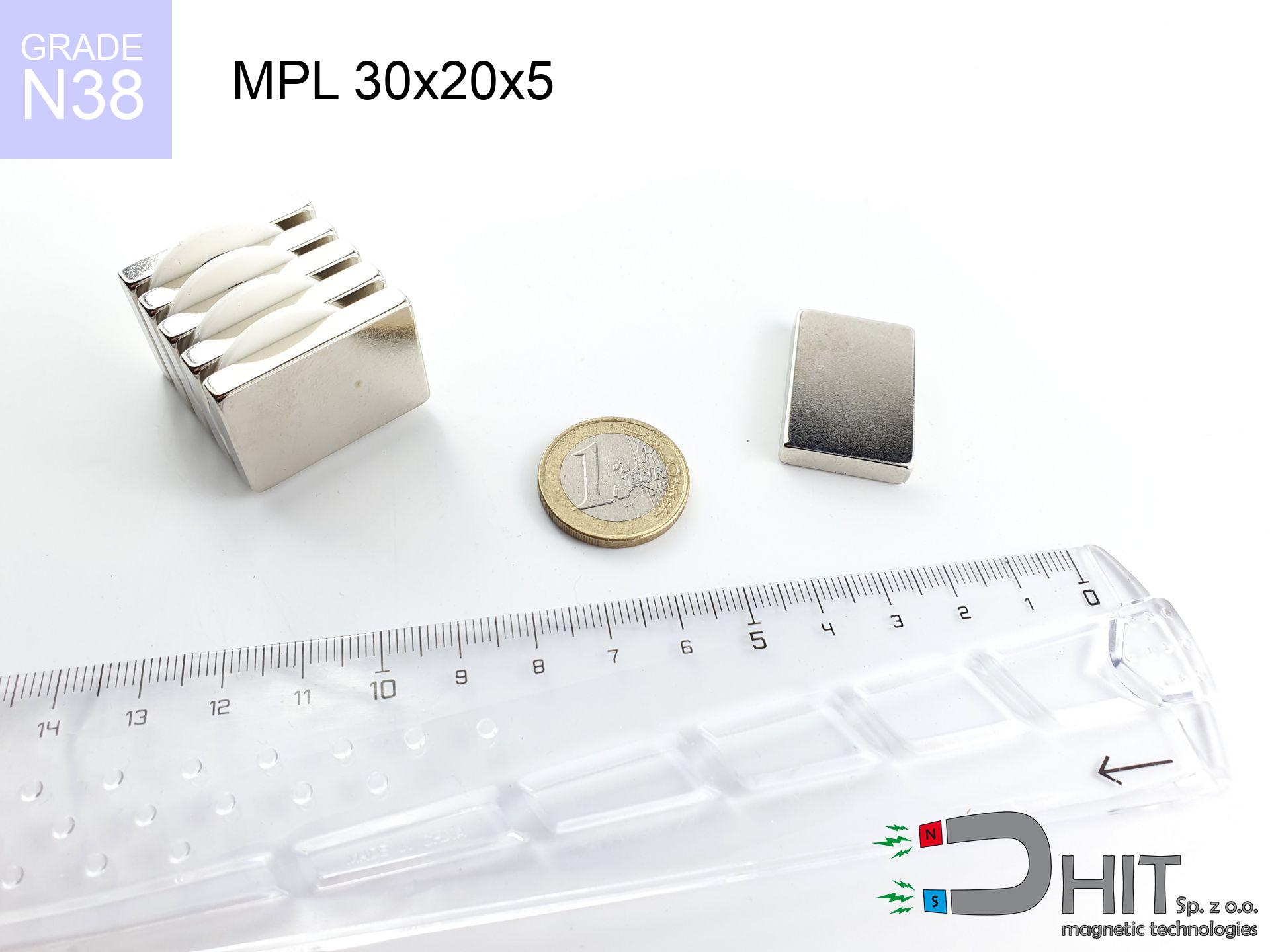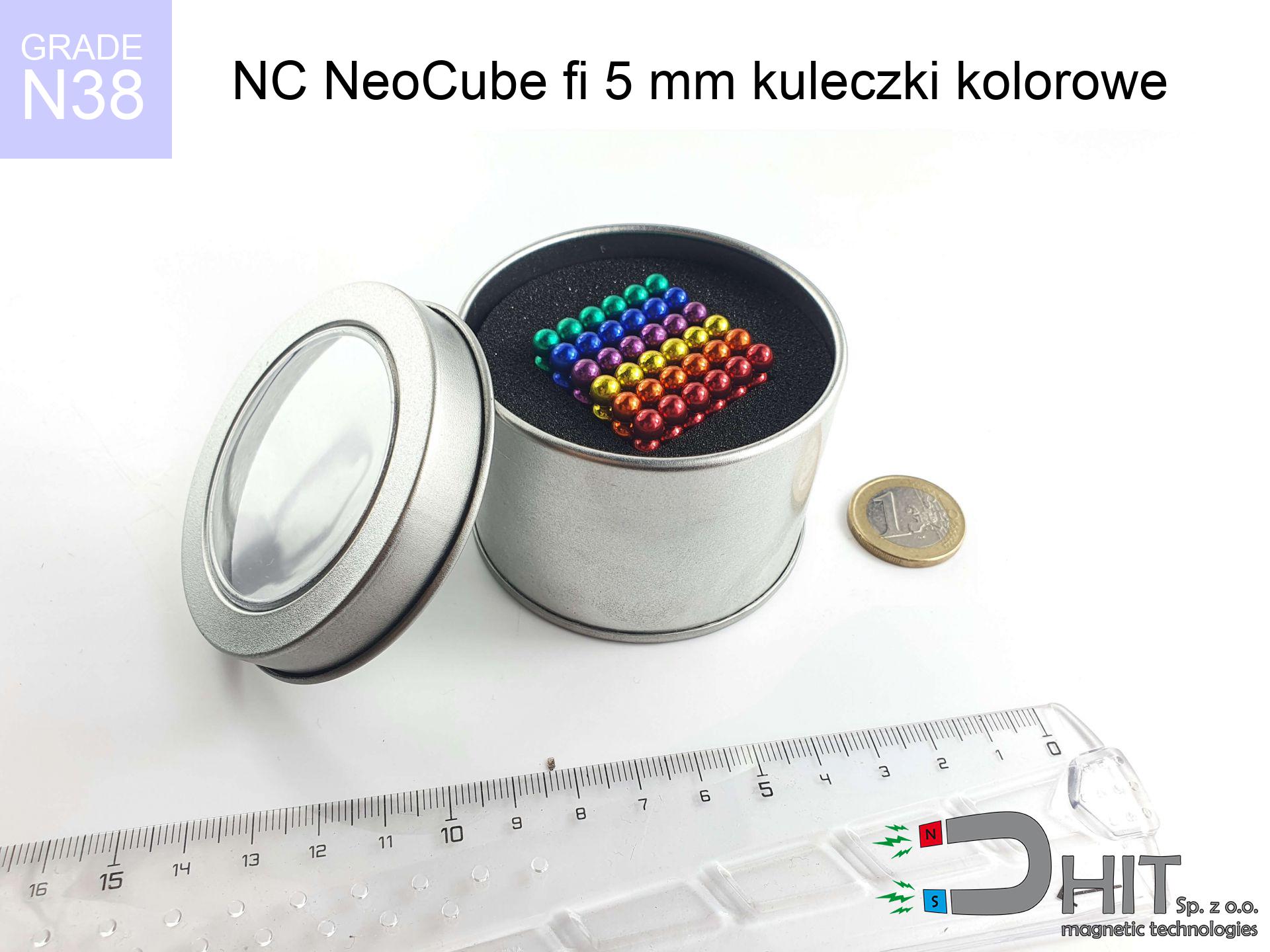MPL 20x8x4 / N38 - lamellar magnet
lamellar magnet
Catalog no 020133
GTIN/EAN: 5906301811398
length
20 mm [±0,1 mm]
Width
8 mm [±0,1 mm]
Height
4 mm [±0,1 mm]
Weight
4.8 g
Magnetization Direction
↑ axial
Load capacity
4.79 kg / 46.98 N
Magnetic Induction
336.99 mT / 3370 Gs
Coating
[NiCuNi] Nickel
3.67 ZŁ with VAT / pcs + price for transport
2.98 ZŁ net + 23% VAT / pcs
bulk discounts:
Need more?Want to negotiate?
Pick up the phone and ask
+48 888 99 98 98
alternatively send us a note via
inquiry form
through our site.
Strength along with shape of a magnet can be analyzed on our
magnetic mass calculator.
Orders submitted before 14:00 will be dispatched today!
MPL 20x8x4 / N38 - lamellar magnet
Specification / characteristics MPL 20x8x4 / N38 - lamellar magnet
| properties | values |
|---|---|
| Cat. no. | 020133 |
| GTIN/EAN | 5906301811398 |
| Production/Distribution | Dhit sp. z o.o. |
| Country of origin | Poland / China / Germany |
| Customs code | 85059029 |
| length | 20 mm [±0,1 mm] |
| Width | 8 mm [±0,1 mm] |
| Height | 4 mm [±0,1 mm] |
| Weight | 4.8 g |
| Magnetization Direction | ↑ axial |
| Load capacity ~ ? | 4.79 kg / 46.98 N |
| Magnetic Induction ~ ? | 336.99 mT / 3370 Gs |
| Coating | [NiCuNi] Nickel |
| Manufacturing Tolerance | ±0.1 mm |
Magnetic properties of material N38
| properties | values | units |
|---|---|---|
| remenance Br [min. - max.] ? | 12.2-12.6 | kGs |
| remenance Br [min. - max.] ? | 1220-1260 | mT |
| coercivity bHc ? | 10.8-11.5 | kOe |
| coercivity bHc ? | 860-915 | kA/m |
| actual internal force iHc | ≥ 12 | kOe |
| actual internal force iHc | ≥ 955 | kA/m |
| energy density [min. - max.] ? | 36-38 | BH max MGOe |
| energy density [min. - max.] ? | 287-303 | BH max KJ/m |
| max. temperature ? | ≤ 80 | °C |
Physical properties of sintered neodymium magnets Nd2Fe14B at 20°C
| properties | values | units |
|---|---|---|
| Vickers hardness | ≥550 | Hv |
| Density | ≥7.4 | g/cm3 |
| Curie Temperature TC | 312 - 380 | °C |
| Curie Temperature TF | 593 - 716 | °F |
| Specific resistance | 150 | μΩ⋅cm |
| Bending strength | 250 | MPa |
| Compressive strength | 1000~1100 | MPa |
| Thermal expansion parallel (∥) to orientation (M) | (3-4) x 10-6 | °C-1 |
| Thermal expansion perpendicular (⊥) to orientation (M) | -(1-3) x 10-6 | °C-1 |
| Young's modulus | 1.7 x 104 | kg/mm² |
Physical analysis of the product - data
Presented data are the direct effect of a engineering calculation. Values rely on algorithms for the class Nd2Fe14B. Operational conditions might slightly differ from theoretical values. Please consider these calculations as a supplementary guide for designers.
MPL 20x8x4 / N38
| Distance (mm) | Induction (Gauss) / mT | Pull Force (kg) | Risk Status |
|---|---|---|---|
| 0 mm |
3368 Gs
336.8 mT
|
4.79 kg / 4790.0 g
47.0 N
|
warning |
| 1 mm |
2818 Gs
281.8 mT
|
3.35 kg / 3352.3 g
32.9 N
|
warning |
| 2 mm |
2266 Gs
226.6 mT
|
2.17 kg / 2167.6 g
21.3 N
|
warning |
| 3 mm |
1794 Gs
179.4 mT
|
1.36 kg / 1358.6 g
13.3 N
|
low risk |
| 5 mm |
1130 Gs
113.0 mT
|
0.54 kg / 538.9 g
5.3 N
|
low risk |
| 10 mm |
416 Gs
41.6 mT
|
0.07 kg / 73.0 g
0.7 N
|
low risk |
| 15 mm |
187 Gs
18.7 mT
|
0.01 kg / 14.7 g
0.1 N
|
low risk |
| 20 mm |
97 Gs
9.7 mT
|
0.00 kg / 4.0 g
0.0 N
|
low risk |
| 30 mm |
35 Gs
3.5 mT
|
0.00 kg / 0.5 g
0.0 N
|
low risk |
| 50 mm |
9 Gs
0.9 mT
|
0.00 kg / 0.0 g
0.0 N
|
low risk |
MPL 20x8x4 / N38
| Distance (mm) | Friction coefficient | Pull Force (kg) |
|---|---|---|
| 0 mm | Stal (~0.2) |
0.96 kg / 958.0 g
9.4 N
|
| 1 mm | Stal (~0.2) |
0.67 kg / 670.0 g
6.6 N
|
| 2 mm | Stal (~0.2) |
0.43 kg / 434.0 g
4.3 N
|
| 3 mm | Stal (~0.2) |
0.27 kg / 272.0 g
2.7 N
|
| 5 mm | Stal (~0.2) |
0.11 kg / 108.0 g
1.1 N
|
| 10 mm | Stal (~0.2) |
0.01 kg / 14.0 g
0.1 N
|
| 15 mm | Stal (~0.2) |
0.00 kg / 2.0 g
0.0 N
|
| 20 mm | Stal (~0.2) |
0.00 kg / 0.0 g
0.0 N
|
| 30 mm | Stal (~0.2) |
0.00 kg / 0.0 g
0.0 N
|
| 50 mm | Stal (~0.2) |
0.00 kg / 0.0 g
0.0 N
|
MPL 20x8x4 / N38
| Surface type | Friction coefficient / % Mocy | Max load (kg) |
|---|---|---|
| Raw steel |
µ = 0.3
30% Nominalnej Siły
|
1.44 kg / 1437.0 g
14.1 N
|
| Painted steel (standard) |
µ = 0.2
20% Nominalnej Siły
|
0.96 kg / 958.0 g
9.4 N
|
| Oily/slippery steel |
µ = 0.1
10% Nominalnej Siły
|
0.48 kg / 479.0 g
4.7 N
|
| Magnet with anti-slip rubber |
µ = 0.5
50% Nominalnej Siły
|
2.40 kg / 2395.0 g
23.5 N
|
MPL 20x8x4 / N38
| Steel thickness (mm) | % power | Real pull force (kg) |
|---|---|---|
| 0.5 mm |
|
0.48 kg / 479.0 g
4.7 N
|
| 1 mm |
|
1.20 kg / 1197.5 g
11.7 N
|
| 2 mm |
|
2.40 kg / 2395.0 g
23.5 N
|
| 5 mm |
|
4.79 kg / 4790.0 g
47.0 N
|
| 10 mm |
|
4.79 kg / 4790.0 g
47.0 N
|
MPL 20x8x4 / N38
| Ambient temp. (°C) | Power loss | Remaining pull | Status |
|---|---|---|---|
| 20 °C | 0.0% |
4.79 kg / 4790.0 g
47.0 N
|
OK |
| 40 °C | -2.2% |
4.68 kg / 4684.6 g
46.0 N
|
OK |
| 60 °C | -4.4% |
4.58 kg / 4579.2 g
44.9 N
|
|
| 80 °C | -6.6% |
4.47 kg / 4473.9 g
43.9 N
|
|
| 100 °C | -28.8% |
3.41 kg / 3410.5 g
33.5 N
|
MPL 20x8x4 / N38
| Gap (mm) | Attraction (kg) (N-S) | Repulsion (kg) (N-N) |
|---|---|---|
| 0 mm |
11.19 kg / 11189 g
109.8 N
4 784 Gs
|
N/A |
| 1 mm |
9.49 kg / 9494 g
93.1 N
6 205 Gs
|
8.54 kg / 8544 g
83.8 N
~0 Gs
|
| 2 mm |
7.83 kg / 7830 g
76.8 N
5 635 Gs
|
7.05 kg / 7047 g
69.1 N
~0 Gs
|
| 3 mm |
6.34 kg / 6337 g
62.2 N
5 069 Gs
|
5.70 kg / 5703 g
55.9 N
~0 Gs
|
| 5 mm |
4.02 kg / 4015 g
39.4 N
4 035 Gs
|
3.61 kg / 3614 g
35.4 N
~0 Gs
|
| 10 mm |
1.26 kg / 1259 g
12.3 N
2 259 Gs
|
1.13 kg / 1133 g
11.1 N
~0 Gs
|
| 20 mm |
0.17 kg / 171 g
1.7 N
832 Gs
|
0.15 kg / 154 g
1.5 N
~0 Gs
|
| 50 mm |
0.00 kg / 3 g
0.0 N
112 Gs
|
0.00 kg / 0 g
0.0 N
~0 Gs
|
MPL 20x8x4 / N38
| Object / Device | Limit (Gauss) / mT | Safe distance |
|---|---|---|
| Pacemaker | 5 Gs (0.5 mT) | 6.5 cm |
| Hearing aid | 10 Gs (1.0 mT) | 5.0 cm |
| Timepiece | 20 Gs (2.0 mT) | 4.0 cm |
| Phone / Smartphone | 40 Gs (4.0 mT) | 3.0 cm |
| Car key | 50 Gs (5.0 mT) | 3.0 cm |
| Payment card | 400 Gs (40.0 mT) | 1.5 cm |
| HDD hard drive | 600 Gs (60.0 mT) | 1.0 cm |
MPL 20x8x4 / N38
| Start from (mm) | Speed (km/h) | Energy (J) | Predicted outcome |
|---|---|---|---|
| 10 mm |
32.16 km/h
(8.93 m/s)
|
0.19 J | |
| 30 mm |
55.18 km/h
(15.33 m/s)
|
0.56 J | |
| 50 mm |
71.24 km/h
(19.79 m/s)
|
0.94 J | |
| 100 mm |
100.75 km/h
(27.99 m/s)
|
1.88 J |
MPL 20x8x4 / N38
| Technical parameter | Value / Description |
|---|---|
| Coating type | [NiCuNi] Nickel |
| Layer structure | Nickel - Copper - Nickel |
| Layer thickness | 10-20 µm |
| Salt spray test (SST) ? | 24 h |
| Recommended environment | Indoors only (dry) |
MPL 20x8x4 / N38
| Parameter | Value | SI Unit / Description |
|---|---|---|
| Magnetic Flux | 5 277 Mx | 52.8 µWb |
| Pc Coefficient | 0.38 | Low (Flat) |
MPL 20x8x4 / N38
| Environment | Effective steel pull | Effect |
|---|---|---|
| Air (land) | 4.79 kg | Standard |
| Water (riverbed) |
5.48 kg
(+0.69 kg Buoyancy gain)
|
+14.5% |
1. Wall mount (shear)
*Warning: On a vertical wall, the magnet retains merely approx. 20-30% of its max power.
2. Efficiency vs thickness
*Thin steel (e.g. 0.5mm PC case) severely limits the holding force.
3. Power loss vs temp
*For N38 grade, the critical limit is 80°C.
4. Demagnetization curve and operating point (B-H)
chart generated for the permeance coefficient Pc (Permeance Coefficient) = 0.38
The chart above illustrates the magnetic characteristics of the material within the second quadrant of the hysteresis loop. The solid red line represents the demagnetization curve (material potential), while the dashed blue line is the load line based on the magnet's geometry. The Pc (Permeance Coefficient), also known as the load line slope, is a dimensionless value that describes the relationship between the magnet's shape and its magnetic stability. The intersection of these two lines (the black dot) is the operating point — it determines the actual magnetic flux density generated by the magnet in this specific configuration. A higher Pc value means the magnet is more 'slender' (tall relative to its area), resulting in a higher operating point and better resistance to irreversible demagnetization caused by external fields or temperature. A value of 0.42 is relatively low (typical for flat magnets), meaning the operating point is closer to the 'knee' of the curve — caution is advised when operating at temperatures near the maximum limit to avoid strength loss.
Elemental analysis
| iron (Fe) | 64% – 68% |
| neodymium (Nd) | 29% – 32% |
| boron (B) | 1.1% – 1.2% |
| dysprosium (Dy) | 0.5% – 2.0% |
| coating (Ni-Cu-Ni) | < 0.05% |
Sustainability
| recyclability (EoL) | 100% |
| recycled raw materials | ~10% (pre-cons) |
| carbon footprint | low / zredukowany |
| waste code (EWC) | 16 02 16 |
Other proposals
Advantages and disadvantages of Nd2Fe14B magnets.
Pros
- They retain full power for around ten years – the loss is just ~1% (based on simulations),
- They are extremely resistant to demagnetization induced by external field influence,
- By using a shiny layer of nickel, the element gains an professional look,
- The surface of neodymium magnets generates a strong magnetic field – this is a distinguishing feature,
- Due to their durability and thermal resistance, neodymium magnets are capable of operate (depending on the shape) even at high temperatures reaching 230°C or more...
- Thanks to the option of flexible forming and adaptation to specialized solutions, NdFeB magnets can be modeled in a broad palette of forms and dimensions, which makes them more universal,
- Fundamental importance in innovative solutions – they are commonly used in hard drives, electric drive systems, medical equipment, and industrial machines.
- Compactness – despite small sizes they generate large force, making them ideal for precision applications
Cons
- At very strong impacts they can break, therefore we advise placing them in steel cases. A metal housing provides additional protection against damage, as well as increases the magnet's durability.
- When exposed to high temperature, neodymium magnets suffer a drop in force. Often, when the temperature exceeds 80°C, their strength decreases (depending on the size, as well as shape of the magnet). For those who need magnets for extreme conditions, we offer [AH] versions withstanding up to 230°C
- They oxidize in a humid environment - during use outdoors we advise using waterproof magnets e.g. in rubber, plastic
- Limited possibility of creating nuts in the magnet and complex shapes - preferred is a housing - mounting mechanism.
- Possible danger to health – tiny shards of magnets can be dangerous, if swallowed, which is particularly important in the aspect of protecting the youngest. Additionally, tiny parts of these magnets can disrupt the diagnostic process medical when they are in the body.
- Higher cost of purchase is one of the disadvantages compared to ceramic magnets, especially in budget applications
Lifting parameters
Maximum magnetic pulling force – what it depends on?
- on a block made of mild steel, optimally conducting the magnetic field
- with a thickness no less than 10 mm
- characterized by lack of roughness
- without any insulating layer between the magnet and steel
- under vertical force vector (90-degree angle)
- at room temperature
Practical lifting capacity: influencing factors
- Space between surfaces – every millimeter of distance (caused e.g. by veneer or dirt) significantly weakens the pulling force, often by half at just 0.5 mm.
- Loading method – declared lifting capacity refers to pulling vertically. When applying parallel force, the magnet holds much less (often approx. 20-30% of maximum force).
- Steel thickness – insufficiently thick plate causes magnetic saturation, causing part of the power to be escaped into the air.
- Plate material – mild steel attracts best. Alloy admixtures lower magnetic permeability and holding force.
- Surface quality – the smoother and more polished the plate, the better the adhesion and higher the lifting capacity. Unevenness acts like micro-gaps.
- Thermal environment – heating the magnet causes a temporary drop of induction. Check the maximum operating temperature for a given model.
Holding force was measured on a smooth steel plate of 20 mm thickness, when a perpendicular force was applied, in contrast under shearing force the holding force is lower. Additionally, even a small distance between the magnet and the plate reduces the holding force.
Crushing force
Danger of trauma: The attraction force is so immense that it can cause blood blisters, pinching, and even bone fractures. Protective gloves are recommended.
Threat to navigation
An intense magnetic field disrupts the functioning of compasses in smartphones and navigation systems. Keep magnets near a smartphone to avoid breaking the sensors.
Safe operation
Before starting, check safety instructions. Uncontrolled attraction can break the magnet or hurt your hand. Think ahead.
Cards and drives
Intense magnetic fields can destroy records on credit cards, hard drives, and other magnetic media. Keep a distance of at least 10 cm.
Eye protection
Despite metallic appearance, neodymium is brittle and cannot withstand shocks. Avoid impacts, as the magnet may crumble into hazardous fragments.
This is not a toy
Product intended for adults. Small elements can be swallowed, causing intestinal necrosis. Store away from children and animals.
ICD Warning
For implant holders: Powerful magnets disrupt medical devices. Maintain at least 30 cm distance or request help to work with the magnets.
Heat sensitivity
Monitor thermal conditions. Heating the magnet above 80 degrees Celsius will permanently weaken its magnetic structure and strength.
Sensitization to coating
Medical facts indicate that the nickel plating (the usual finish) is a strong allergen. If you have an allergy, avoid direct skin contact and select coated magnets.
Flammability
Fire hazard: Neodymium dust is highly flammable. Do not process magnets without safety gear as this may cause fire.









